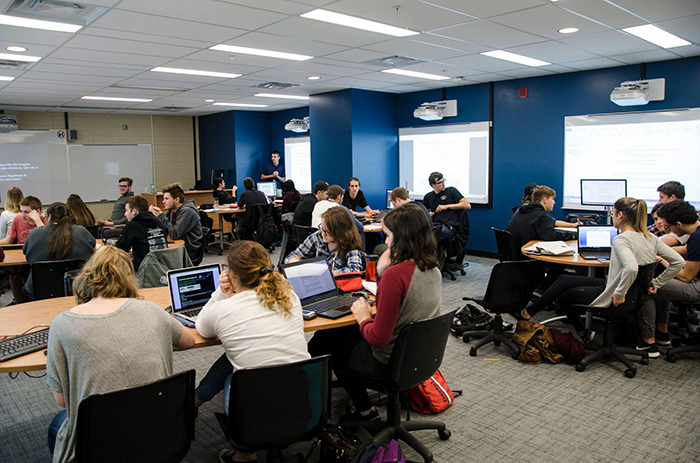Why and How to Rethink Classroom Design?
Nowadays, thanks to technology, learners are connected to content from beyond any physical space. Learning online, flipped classrooms and technology-based learning strategies are many relatively new trends. These trends allow learners the liberty to learn at their own rhythm and provide access to interactive media that enhance and diversify teaching strategies. On the other hand digital learning requires we rethink the traditional classroom design.
In his book Teaching in a Digital Age: Guidelines for designing teaching and learning (2015), Tony Bates proposes an in depth reflection on the classroom. I will focus more on the sections “Rethinking the design of classrooms” and “The impact of flipped classrooms and hybrid learning on classroom design” in order to present the factors to consider to improve the ergonomics of 21st century classrooms.
Why review classroom design?
The progressive transition from traditional courses towards digital and more interactive learning calls for special attention to be paid to learning spaces. At first sight, traditional learning spaces do not seem to have undergone any changes that might allow an optimal integration of technology. However, according to Bates, modern pedagogical practices and classroom design should mutually influence one another.
As we move from lectures to more interactive learning, we will need to think about the spaces in which learning will take place, and how pedagogy, online learning and the design of learning spaces influence one another.
The interaction between modern learning practices and physical layout of the classroom
To understand how modern learning practices and the physical layout of classrooms interact, it is important to understand the 3 key elements of an efficient learning system:
- Pedagogy (applied teaching and learning methods):
- Flipped classroom approach
- Lectures
- Group work
- Methods of presenting information
- Technology (tangible & intangible):
- Laptop
- Projector
- Interactive whiteboard
- Applications
- Software, etc.
- Space (size, adaptability and flexibility of the room and its furniture are to be considered)
The areas of influence are as follows:
- Pedagogy is the basis for technological choices. The technology used should not be randomly chosen or, even less, be based on catering to the latest fad.
- Space has an influence on the choice of technology. Some classrooms cannot accommodate digital tools and large technological accessories that would require adapting room layout. Teachers should opt for technology that is adapted to the available space.
- Space affects pedagogy. The possibilities that a space offers can hinder or facilitate the use of a teaching method.
Thus, it can be noted that technology supports teaching methods whereas space is a non-negligible constraint that tends to lessen teachers choices among the numerous possibilities available nowadays.
Ultimately, classroom space should allow pedagogy and technology to blend adequately in order to create a learning ecosystem and ensure its effectiveness.
Trends that influence classroom layout
Some current pedagogical strategies have an incidence on the way a classroom is set up. Furthermore, the choice of technology can require the use of accessories and equipment that facilitate implementation of the strategies.
| Technology (tangible & intangible) | New layout & equipment |
|---|---|
| Use of basic technology | |
|
|
| Presenting and sharing information, sharing digital content (visuals and audio) | |
| Wall mounted installations (projections screen, television, interactive whiteboard) |
|
| Collaborative work, games and simulations | |
|
|
| Tutoring / Mentoring | |
| Wall mounted installations (projections screen, television, interactive whiteboard) |
|
| Self-learning | |
|
Private spaces (reading zone) |

Design facilitating collaborative work and content sharing (Collège Ahuntsic). (Source:@samuelfstlauren)
Is classroom redesign truly necessary?
Because the social function of classrooms constitutes a substantial advantage, they will likely never completely disappear. However, with online learning increasing it is important to ask ourselves what type of classroom will really be needed in the decades to come. Will they be used for the same purposes as today? What types of classroom designs should be given priority?

«Puzzle» tables that transition easily to teamwork (Collégial international Sainte-Anne). (Source: AQuest Design)

Ryan Moon, Editor for the English Edition of Profweb, wrote an article on the design of an active learning classroom at LaSalle College.
Some basic features
To ensure that the use of technology in a class is optimal, it must enrich the activities carried out and enable the learning objectives to be met. Some basic features classrooms can be fitted out with to support practices already widely in use:
- Lockers for safe storage of laptops and accessories
- Furniture with integrated power hubs
- Wall mounted installations for projections and presentations
- Flexible and convertible furniture that can be moved easily to facilitate collaborative work

A modern classroom design for the digital age (Cégep Limoilou). (Source: article de Profweb)
Institutions will undoubtedly have to take into consideration how pedagogy, technology and space mutually shape each other. However, first and foremost, it would be wise to focus on the impact that the learning environment (from the traditional classroom to the virtual classroom and all of the hybrid models in between) has on the efficiency in learning. All in all, these are the considerations that will influence investment in the infrastructure and digital materials.
Tony Bates raises the following question: would it be preferable to invest in the transformation of current classrooms or invest in the construction of new learning spaces? What do you think? Do not hesitate to send me your comments!

